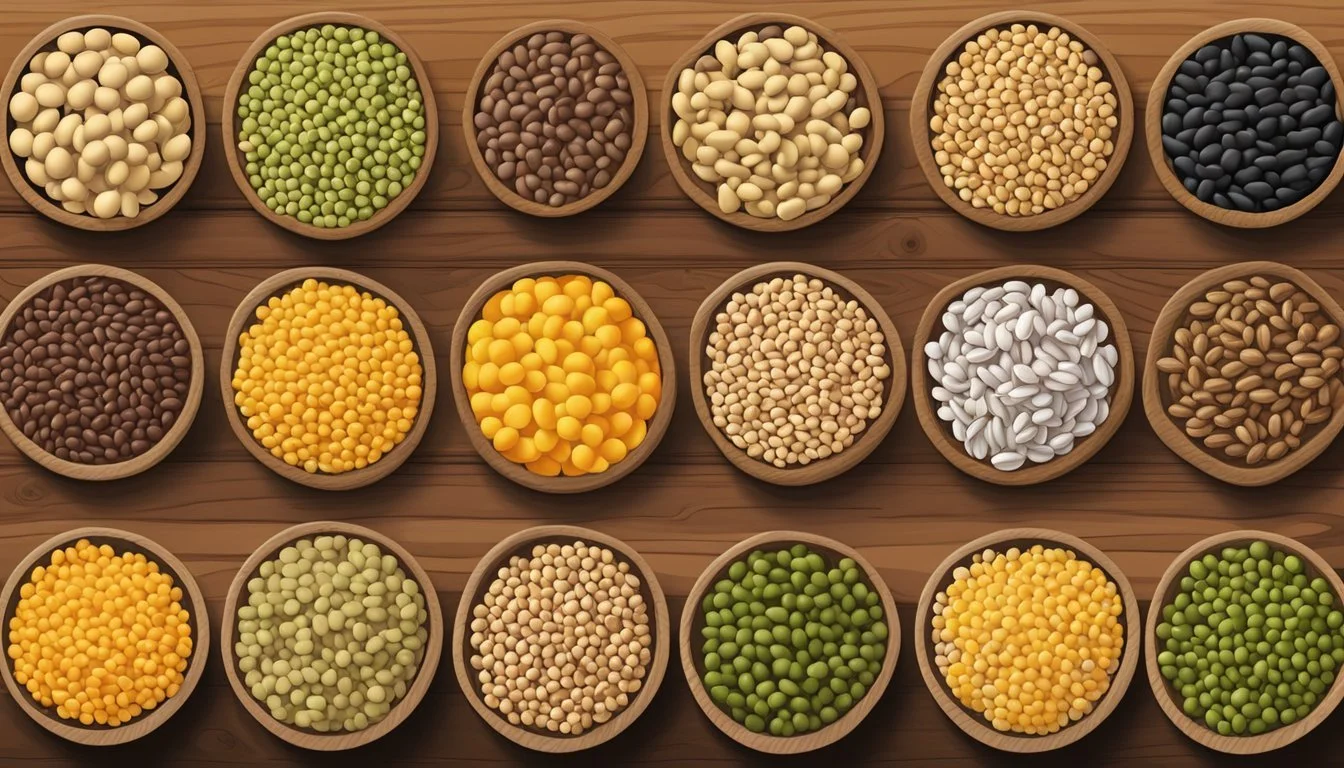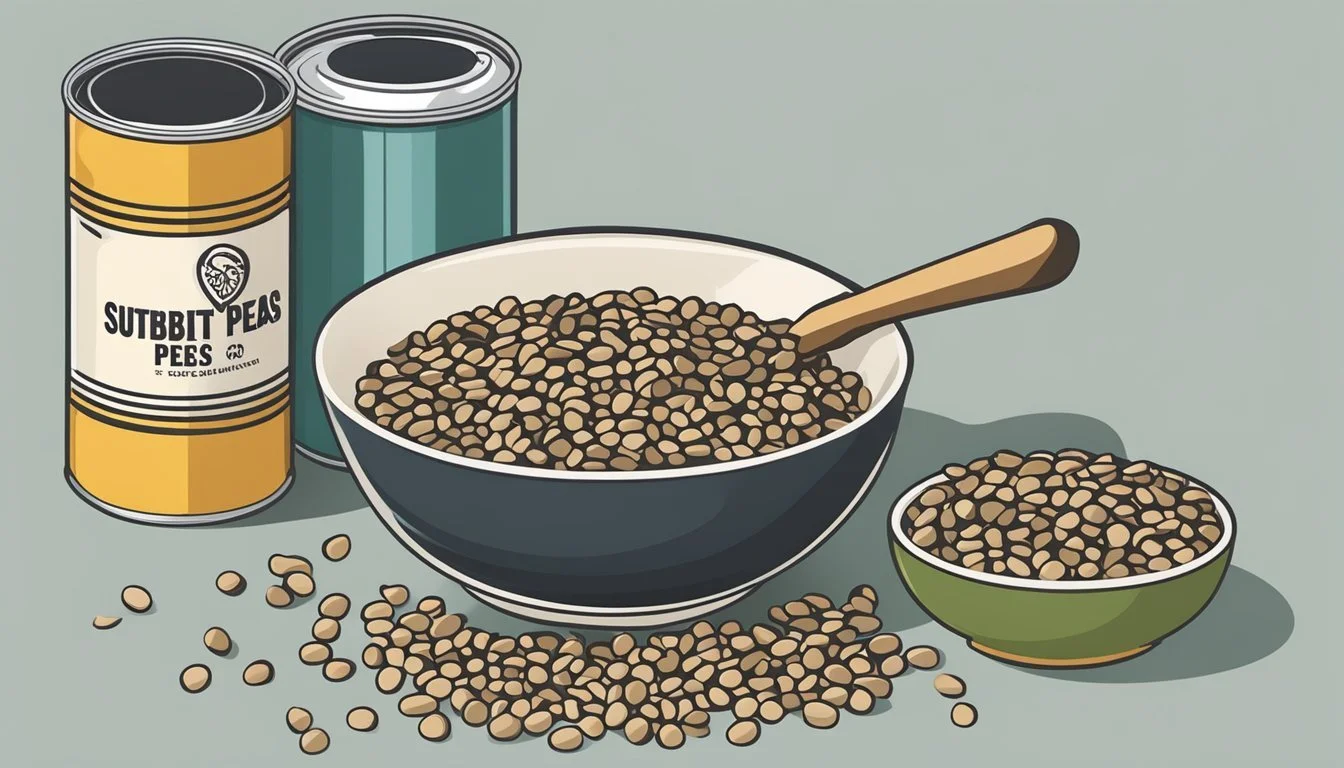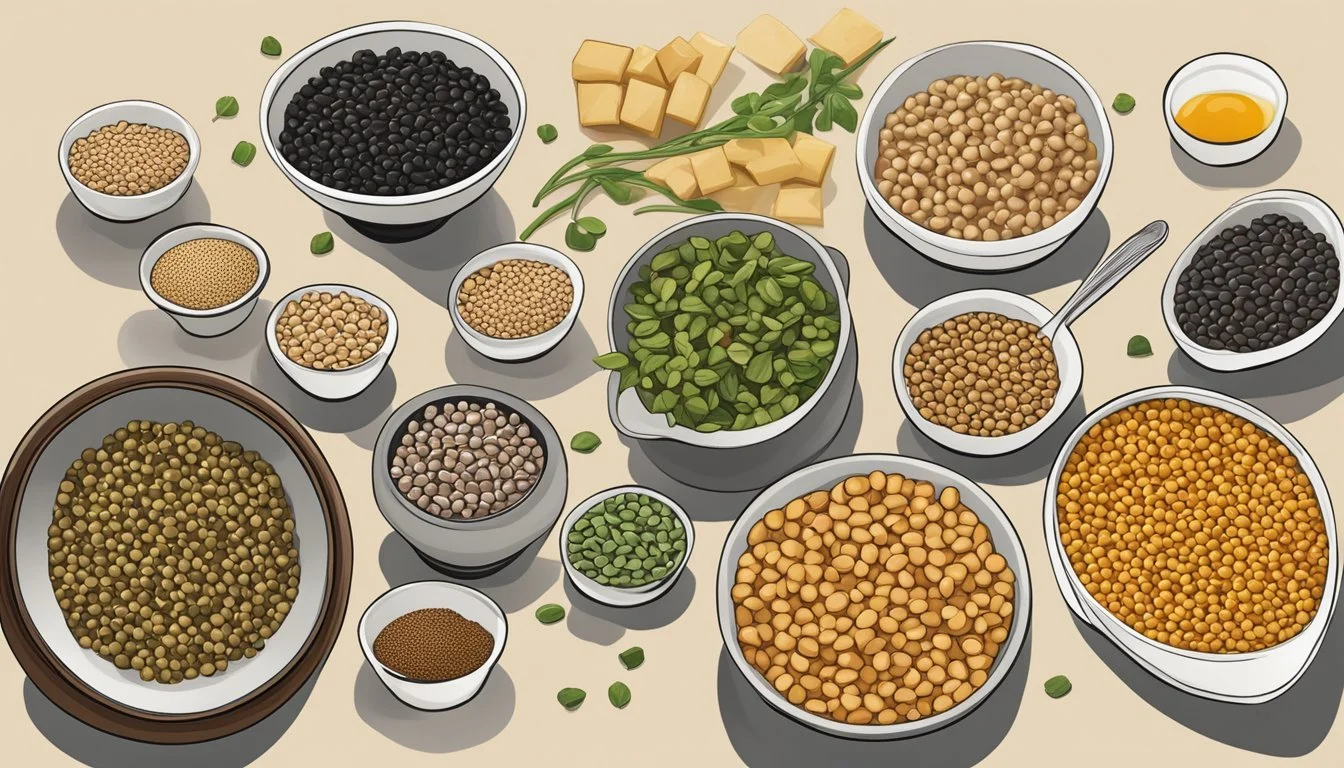Black-eyed Peas Substitutes
Top Alternatives for Your Recipes
Finding the right substitute for black-eyed peas can be a game-changer in the kitchen, especially when you’re in the middle of cooking and realize you're out of this crucial ingredient. Substitutes like fresh Romano beans, white navy beans, and Kentucky Wonder beans can perfectly replicate the creamy texture and mild flavor of black-eyed peas. These alternatives not only soak up flavors well but also maintain nutritional value, making your dishes just as tasty and wholesome.
Romano beans, for instance, offer a similar color and consistency, though it's important not to overcook them to avoid a mushy texture. Great Northern beans, also known as white navy beans, share a creamy texture and mild, earthy flavor that pairs well with strong spices or bold flavors in a variety of recipes.
Kentucky Wonder beans, with their nutty flavor and ability to thrive in soups, stews, and chilis, present another excellent option. For those looking to mix up their usual choice, lima beans are also worth considering due to their slightly starchy taste and smooth texture when properly cooked.
Understanding Black-Eyed Peas
Black-eyed peas are a unique legume characterized by their distinct flavor and nutritional benefits, and they also hold cultural significance in various regions.
Culinary Profile
Black-eyed peas have a creamy texture and a mild, nutty flavor making them versatile in different dishes. Often used in soups, stews, and salads, their ability to absorb surrounding flavors makes them a favorite in various cuisines.
Popular in Southern and African-American culinary traditions, these peas are often cooked with spices and meats, particularly pork. Their flavor profile complements hearty dishes, providing both substance and subtlety.
Nutritional Benefits
Black-eyed peas are a powerhouse of nutrients. Rich in protein and fiber, they support digestion and help maintain muscle health.
They are also packed with essential vitamins and minerals. Iron, zinc, potassium, magnesium, calcium, and folate are abundant, contributing to various bodily functions.
These peas are particularly beneficial for heart health due to their high levels of antioxidants and fiber. By keeping cholesterol levels in check, they support cardiovascular health effectively.
Cultural Significance
Black-eyed peas hold special importance in certain cultural practices. In Southern American cuisine, they are a traditional dish for New Year’s Day, believed to bring good luck and prosperity. This tradition is especially strong in African-American communities.
In African cuisine, black-eyed peas are a staple ingredient used in many traditional dishes. Their symbolic role extends beyond nutrition, often associated with wealth and fortune in various cultural rituals.
These beans play a pivotal role in bridging culinary traditions with cultural practices, making their presence in any dish both flavorful and meaningful.
Common Substitutes for Black-Eyed Peas
For those looking to replace black-eyed peas in recipes, a variety of beans, legumes, and grains offer similar textures and flavors, ensuring dishes maintain their nutritional value and appeal. These alternatives can easily be found in grocery stores.
Beans and Legumes
White Navy Beans
White navy beans, or Great Northern beans, provide a creamy texture and mild, earthy flavor. This makes them ideal for soups, stews, and casseroles. Nutrient-rich and versatile, they pair well with strong spices used in many black-eyed pea dishes.
Romano Beans
Romano beans offer a sweet, delicate flavor, perfect for Italian-inspired recipes. They should not be overcooked, as they can become mushy. They blend well with fresh tomatoes and basil, adding elegance to a variety of dishes.
Kentucky Wonder Beans
Kentucky wonder beans bring a creamy texture and nutty flavor to soups, stews, and chilis. Originally from Kentucky, these beans enhance dishes with their rich taste and are widely available in grocery stores.
Grains and Other Substitutes
Lentils
Lentils are a great substitute, particularly in stews and soups. Their quick cooking time and high protein content make them a convenient and nutritious option. They come in various colors, adding both visual and taste variety to meals.
Chickpeas
Chickpeas, or garbanzo beans, offer a nutty flavor and firm texture. They are excellent in salads, soups, and even as a snack. Their versatility and health benefits make them a popular substitute for black-eyed peas.
Green Peas
Green peas can be an unexpected yet effective substitute in some recipes. They are sweet, tender, and easily blend into various dishes, providing a lighter alternative to black-eyed peas.
Substitutes by Cooking Application
Finding the right substitutes for black-eyed peas can depend on the specific dish you are preparing. Whether you're making salads, soups, stews, Southern cuisine, or vegetarian dishes, there are suitable alternatives that will still offer flavorful and satisfying results.
Substitutes in Salads
For salads, White Navy Beans and Cannellini Beans are excellent substitutes. These beans have a mild flavor and creamy texture that blends well with fresh vegetables and dressings.
Romano Beans can also be used, providing a slightly different texture but still complementing other salad ingredients. They should be cooked just right to avoid becoming mushy.
Substitutes in Soups and Stews
In soups and stews, Great Northern Beans and Cannellini Beans are ideal. These beans maintain their shape well during cooking and add a creamy texture to the broth.
Chickpeas are another good option, offering a slightly firmer texture which can add variety to the soup’s consistency. Additionally, Lima Beans can be used for their similar cooking time and hearty texture.
Substitutes in Southern Cuisine
For traditional Southern cuisine, Crowder Peas and Field Peas are great options. Coming from the same family, they share a similar taste and texture with black-eyed peas.
Purple Hull Peas are another alternative, known for their vibrant appearance and familiar flavor that’s integral to Southern dishes. They can be cooked in the same manner as black-eyed peas without altering classic recipes.
Substitutes in Vegetarian Dishes
In vegetarian dishes, Lentils and Chickpeas stand out. These legumes provide substantial protein and a satisfying bite, making them excellent replacements.
Mung Beans can also be considered for their nutrient profile and similar cooking methods. Split Peas are another alternative, especially in dishes like vegetarian shepherd's pie or veggie patties, giving both texture and flavor similar to black-eyed peas.
Choosing the Right Substitute
When choosing a substitute for black-eyed peas, consider factors like flavor, texture, and nutritional value. These considerations help ensure you select the best possible alternative for your recipe's specific needs.
Flavor Considerations
Flavor is a critical element in choosing a substitute for black-eyed peas. Black-eyed peas have a mild, earthy taste that blends well with various spices and seasonings.
White Navy Beans (Great Northern Beans): These beans share a creamy texture and mild earthy flavor, making them a popular choice. They work well in dishes with strong spices.
Cannellini Beans: Also known as white kidney beans, these have a nutty flavor that can complement many recipes, especially in soups and stews.
Romano Beans: Offering a similar earthy quality, Romano beans can be a good fit, but be cautious not to overcook as they can become mushy.
Texture Preferences
Texture significantly impacts the overall feel of the dish. Black-eyed peas are noted for their firm yet creamy texture that holds up well in both cooked and raw applications.
White Navy Beans: These beans maintain a creamy texture similar to black-eyed peas. Their small size makes them versatile for various dishes, from casseroles to salads.
Cannellini Beans: The larger size and creamy consistency of Cannellini beans make them suitable for dishes where you need a substantial bean presence. Their texture holds well in cooking, becoming tender without breaking apart.
Romano Beans: Romano beans, when cooked properly, preserve their shape and add a firm texture. This makes them suitable for salads and side dishes where you need a bean that holds up under mixing.
Nutritional Considerations
Nutritional value is another crucial aspect. Black-eyed peas are rich in protein, fiber, and essential nutrients, making them a healthy choice for many diets.
White Navy Beans: High in complex carbohydrates, navy beans offer a good amount of dietary fiber and protein. They are also low in fat, making them a heart-healthy option.
Cannellini Beans: Similar to black-eyed peas, Cannellini beans are a rich source of protein and fiber. They also provide essential nutrients like iron and magnesium, supporting overall health.
Romano Beans: Romano beans are nutritious, providing a good mix of protein, fiber, and vitamins. They are an excellent source of plant-based protein and contain important minerals such as potassium and iron.
Preparing Substitutes
Choosing the right method and avoiding common mistakes ensures your black-eyed pea substitutes retain their texture and flavor. The following guidance explores these essential considerations.
Cooking Methods
Properly cooking substitutes like Romano beans, Kentucky Wonder beans, and white navy beans preserves their distinct textures. Romano beans should be cooked until tender but not mushy. Steaming or boiling for around 20-30 minutes is optimal.
Kentucky Wonder beans, with their creamy texture, require slow cooking. Simmering them in soups or stews for at least an hour results in the best consistency.
White navy beans, on the other hand, should be soaked for at least 6 hours before boiling. This prevents the beans from becoming overly soft. Gentle simmering for about 45 minutes is recommended once soaked.
Avoiding Common Mistakes
Avoid common pitfalls to maintain the quality of your substitutes. Overcooking beans can make them overly soft and mushy. Monitoring cooking times closely is essential.
When using lime beans as a substitute, they should be cooked to a smooth, creamy consistency but avoiding over-stirring, which can cause them to become mashed.
Another common mistake is neglecting to soak beans like white navy beans. Proper soaking enhances texture and flavor, making them suitable replacements for black-eyed peas.
Avoid adding acidic ingredients like tomatoes or vinegar during initial cooking stages, as they can toughen the beans. Instead, add these ingredients after the beans have become tender.
By paying close attention to these cooking methods and avoiding common mistakes, one can successfully substitute black-eyed peas without compromising the dish's integrity and flavor.
Substitute Profiles
Selecting the right substitute for black-eyed peas enhances dishes without compromising flavor or nutritional value. Here is a detailed profile of some excellent alternatives.
Pinto Beans
Pinto beans are a versatile and accessible substitute for black-eyed peas. With their creamy texture and mild, earthy flavor, they work well in stews, soups, and salads. These beans are also rich in fiber, protein, and essential nutrients like iron and magnesium.
They blend nicely with spices and absorb flavors well, making them ideal in dishes that typically use black-eyed peas. Pinto beans are also visually appealing due to their speckled appearance when raw, adding an aesthetic touch to your recipes.
Lima Beans and Butter Beans
Lima beans and butter beans, while technically the same, are often differentiated by their size and usage in cooking. Both are starchy with a buttery texture, making them a great match for black-eyed pea recipes. They bring a slight sweetness, enhancing the dish's complexity.
These beans are packed with vitamins and minerals, promoting overall health. To avoid a mushy texture, it's crucial not to overcook them. Lima beans or butter beans can be used in soups, casseroles, and side dishes.
Chickpeas and Garbanzo Beans
Chickpeas, also known as garbanzo beans, are an excellent substitute due to their firm texture and nutty flavor. They are highly nutritious, offering protein, fiber, and several vital vitamins and minerals. Chickpeas are especially good in salads, stews, and even mashed preparations like hummus.
They hold their shape well during cooking, providing a nice bite to dishes. Their versatility is unmatched—they can be roasted for snacks, ground into flour, or even used in desserts.
Other Beans and Peas
Several other legumes can substitute for black-eyed peas in various recipes, such as navy beans and white kidney beans. Navy beans, also known as Boston beans or white pea beans, have a soft texture and mild flavor, suitable for soups and baked dishes.
Romano beans stand out with their vibrant color and slightly sweet flavor. Purple hull peas and crowder peas are close relatives of black-eyed peas and offer similar tastes and textures. Cranberry beans provide a rich, nutty profile that enhances the dish.
Fava beans and black beans also present unique flavors and nutritional benefits, making them suitable as substitutes depending on the recipe's requirements. Each of these legumes brings something unique to the table, catering to diverse culinary needs.
Global Inspirations for Substitutes
Exploring different cuisines around the world reveals a range of substitutes for black-eyed peas. Diverse cultures have unique legumes, often used in traditional dishes, that can replace black-eyed peas effectively.
Mediterranean Alternatives
Romano beans are a staple in Italian cuisine. With their creamy texture and mild flavor, they are ideal for soups and stews, much like black-eyed peas. To prevent them from becoming mushy, it's important not to overcook them.
Chickpeas, another Mediterranean favorite, offer a nutty flavor and firm texture. They are commonly used in dishes such as hummus and salads. When substituting, consider cooking them thoroughly to achieve the desired consistency.
Latin American Options
Pinto beans are commonly found in Mexican cuisine. They have a rich, earthy flavor akin to black-eyed peas and can be used in refried beans, soups, and stews. Pinto beans are an excellent choice for spiced dishes.
Black beans also serve as a versatile substitute. They are nutrient-rich and offer a slightly sweet taste. These beans work well in rice dishes, such as black beans and rice, and hearty stews.
African Influences
Cowpeas are a fundamental part of West African cuisine. Similar to black-eyed peas, they have a subtle flavor and are used in numerous traditional recipes like rice and beans and soups. Cowpeas retain their texture well during cooking.
Lentils, though not a direct substitute, feature in many North African dishes. They offer a different texture but are used in rich, spiced stews and soups. Lentils are quick-cooking and absorb flavors well, making them a versatile choice in various preparations.







